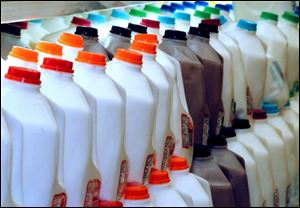
Area milk prices begin to ease from spring spike
8/12/2004
Retail prices rose sharply between April and June.
Milk prices, which had risen an average of 63 cents a gallon nationally two months ago, have started to come down.
But retail prices aren't likely to drop nearly as rapidly as they went up between April and June, said Peter Vitaliano, chief economist for the National Milk Producers Federation, of Arlington, Va.
"There may be some supermarkets concerned about alienating their customers and that will make them drop their prices, but how fast others follow suit depends on competition."
Nationally, the average retail price has dropped 3 cents a gallon over the last two months.
According to the U.S. Department of Agriculture, in July the average retail price of a gallon of milk in the Detroit area - the closest area to Toledo that the government tracks - was $3.33. It was $2.88 a gallon in April before prices started to jump.
But prices paid to producers are falling, which usually leads to cuts in retail prices.
Prices fell about 56 cents a gallon on the commodity market at the end of July, according to the producers federation.
Said John Zimmerman, a spokesman for Meijer Inc., "You can see it slowly going down." Meijer is selling milk for $1.77 a gallon in the Toledo area.
Brian Koenig, president of Wauseon-based Sterling Food Stores, which has 32 carry-outs in northwest Ohio, said he has noticed a slow receding of prices of late.
He said Sterling dropped its price 20 cents a gallon over the last two weeks although, he said, "It's still over the $2 mark."
Dianne Shoemaker, a dairy specialist with Ohio State University's extension office, said a combination of factors pushed prices up sharply in May.
One was an industry program that buys cows to take them off the market and help subsidize exports.
Another was the mad cow disease scare in Canada, which closed the U.S. border to livestock and other products.
"About 40,000 to 60,000 dairy heifers a year were coming to the U.S. from Canada. That took those potential animals out of the dairy population," Ms. Shoemaker said.
Additionally, there was a shortage of a drug that helps cows produce more milk. That still has not been resolved, Ms. Shoemaker said.
Last fall's poor crops of material such as corn and hay that cattle eat hurt milk production.
And high beef prices caused some dairy farmers to send older dairy cows to slaughter.
Contact Jon Chavez at:
jchavez@theblade.com
or 419-724-6128